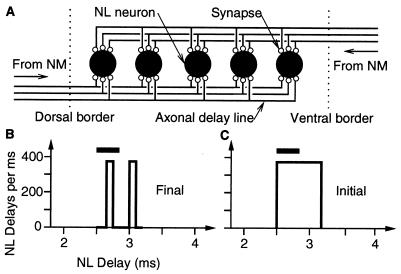Figure 1.
Schematic diagram of the architecture of the nucleus laminaris (NL) as a realization of the Jeffress idea (1, 11) that ITD is mapped along the dorsoventral direction. (A) Part of a single frequency layer. Axonal arbors (full lines) from the contralateral nucleus magnocellularis (NM) enter NL through its ventral border (arrow and dotted line) whereas arbors from the ipsilateral NM enter dorsally. They contact (small open circles) all laminar neurons (large filled circles). Synaptic weights are assumed to be modifiable. We have simulated 30 laminar neurons (5 are shown) and 500 magnocellular afferents, 250 from each side (3 are shown). (B) In adult owls, we propose that, as a result of learning, NL delays (from ear to border of NL) roughly differ by multiples of the best frequency T−1 in the considered NL layer [here T = (3 kHz)−1, horizontal bar]; cf. figure 9 in ref. 13. To this end, we assume that axonal arbors whose synaptic weights vanish are eliminated during development. (C) In young owls, the distribution of NL delays is assumed to be broad with respect to T.

